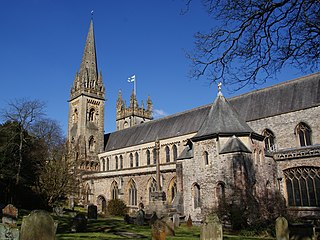
Llandaff Cathedral is an Anglican cathedral and parish church in Llandaff, Cardiff, Wales. It is the seat of the Bishop of Llandaff, head of the Church in Wales Diocese of Llandaff. It is dedicated to Saint Peter and Saint Paul, and three Welsh saints: Dubricius, Teilo and Oudoceus. It is one of two cathedrals in Cardiff, the other being the Roman Catholic Cardiff Metropolitan Cathedral in the city centre.
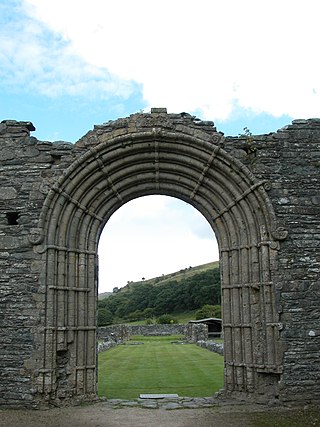
Strata Florida Abbey is a former Cistercian abbey situated just outside Pontrhydfendigaid, near Tregaron in the county of Ceredigion, Wales. The abbey was founded in 1164. After the region around St Davids was firmly occupied by the Norman Marcher lordship of Pembroke by the early 12th century, with St Davids firmly under Norman influence thereafter, the princely Dinefwr family of Deheubarth transferred their patronage to Strata Florida, and interred many of their family members there.

Llandeilo is a town and community in Carmarthenshire, Wales, situated at the crossing of the River Towy by the A483 on a 19th-century stone bridge. Its population was 1,795 at the 2011 Census. It is adjacent to the westernmost point of the Brecon Beacons National Park. The town is served by Llandeilo railway station on the Heart of Wales Line.

Pontarddulais, also known as Pontardulais, is both a community and a town in Swansea, Wales. It is 10 miles (16 km) northwest of the city centre. The Pontarddulais ward is part of the City and County of Swansea. Pontarddulais adjoins the village of Hendy in Carmarthenshire. The built-up population was 9,073.
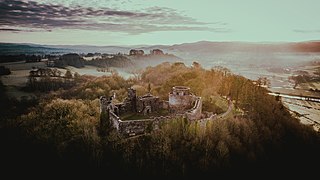
Dinefwr Castle is a ruined castle overlooking the River Towy near the town of Llandeilo, Carmarthenshire, Wales. It lies on a ridge on the northern bank of the Towy, with a steep drop of one hundred feet to the river. Dinefwr was the chief seat of the Dinefwr dynasty of the Kingdom of Deheubarth. The castle is a Grade I listed building.

Picton Castle is a medieval castle near Haverfordwest in the community of Uzmaston, Boulston and Slebech, Pembrokeshire, Wales. Originally built at the end of the 13th century by a Flemish knight, it later came into the hands of Sir John Wogan. The castle and gardens are now owned and managed by the Picton Castle Trust, a registered charity, for the benefit of the public. It is of unusual construction and has been remodelled several times during its history. The castle is a Grade I listed building and its gardens and park are designated at Grade II* on the Cadw/ICOMOS Register of Parks and Gardens of Special Historic Interest in Wales.

Newton House is a Grade II* listed country house situated just to the west of the market town of Llandeilo in Carmarthenshire, Wales. It is partially owned and maintained by the National Trust and lies within Dinefwr Park and the grounds of Dinefwr Castle. The park and gardens are listed on the Cadw/ICOMOS Register of Parks and Gardens of Special Historic Interest in Wales. The original house was built during the Medieval period on a site which has been occupied for at least two millennia. The current house was built by Edward Rice in the Jacobean style in 1660, though extensive changes were made in the 1850s in the Venetian Gothic style. The house played a role in the Rebecca Riots of 1843, when the occupant of the house at the time, Colonel George Rice, received a death threat with an empty grave dug in the ground. After 1956 the property fell into turbulent times when two owners died within the space of a few years. It was sold in 1974, and later fell into disrepair; it was occupied by squatters and thieves who removed beams and furniture.

Llantilio Crossenny is a small village and much larger former community, now in the community of Whitecastle, in Monmouthshire, south east Wales, in the United Kingdom. It is situated between the two towns of Abergavenny and Monmouth on the B4233 road. The community included Penrhos, and Llanvihangel-Ystern-Llewern.
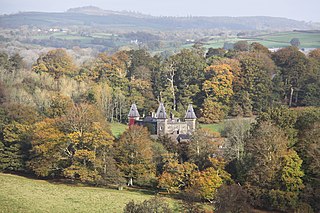
Dinefwr Park National Nature Reserve is an 800 acres (320 ha) estate about a mile from the centre of Llandeilo in Carmarthenshire owned by the National Trust, with a mansion in the centre. The highest point is occupied by the ruined Dinefwr Castle, ancient castle of the Deheubarth kingdom. It is a grade I Historic Park and a Site of Special Scientific Interest.

St Iestyn's Church, Llaniestyn is a medieval church in Llaniestyn, Anglesey, in Wales. A church is said to have been founded here by St Iestyn in the 7th century, with the earliest parts of the present building dating from the 12th century. The church was extended in the 14th century, with further changes over the coming years. It contains a 12th-century font and a 14th-century memorial stone to Iestyn, from the same workshop as the stone to St Pabo at St Pabo's Church, Llanbabo.

St Eleth's Church, Amlwch is a parish church built in the Neo-classical style in 1800 in Amlwch, a town on the island of Anglesey in north Wales. It stands on the site of earlier buildings, with the first church here said to have been established by St Elaeth in the 6th century. Increasing prosperity in the town through copper mining during the 18th century led to the construction of a new church to serve the growing population.

St Mary's Church, Pentraeth is a small medieval parish church in the village of Pentraeth, in Anglesey, north Wales. The date of construction is unknown, but is probably from some time between the 12th to 14th centuries. A church dedicated to St Mary was recorded here in 1254, but there is a tradition that there was an older church dedicated to St Geraint, an early British saint. Some medieval stonework remains in three walls of the building. A chapel was added to the south side in the 16th or 17th century. The church was altered and refurbished during the 19th century, including an extensive rebuilding by Henry Kennedy, the architect for the Diocese of Bangor, in 1882. St Mary's is still used for worship by the Church in Wales, and is one of three churches in a combined parish. Its conservation is specifically included in the aims of a Chester-based charity that promotes health and the arts in Anglesey and the north-west of England.

St Tyfrydog's Church, Llandyfrydog is a small medieval church, in Llandyfrydog, Anglesey, north Wales. The date of establishment of a church on this site is unknown, but one 19th-century Anglesey historian says that it was about 450. The oldest parts of the present building are dated to about 1400, with the chancel dating from the late 15th or early 16th century. It is built from rough, small, squared stones, dressed with limestone. One of the windows on the south side is raised to illuminate the pulpit, a decision that in the eyes of one 19th-century commentator "disfigures the building."
Llandeilo Llwydarth or Llandilo is an ancient area and parish in the Preseli Hills between Llangolman and Maenclochog in the community of Maenclochog, Pembrokeshire, Wales.

Saint Teilo, also known by his Cornish name Eliud, was a British Christian monk, bishop, and founder of monasteries and churches. He was from Penalun (Penally) near Tenby in Pembrokeshire, south Wales.

Upper Talley Lake and Lower Talley Lake are two small lakes immediately north of the village of Talley, 7 miles (11 km) north of Llandeilo in Carmarthenshire, Wales. They are protected as a Site of Special Scientific Interest (SSSI).
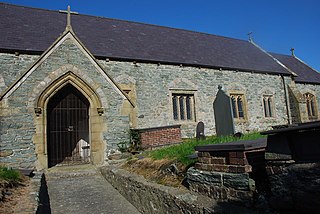
St Edern's Church, Bodedern is a medieval parish church in the village of Bodedern, in Anglesey, north Wales. Although St Edern established a church in the area in the 6th century, the oldest parts of the present building date from the 14th century. Subsequent alterations include the addition of some windows in the 15th century, and a chancel, transept and porch in the 19th century, when the nave walls were largely rebuilt. Stained glass was also inserted into the windows of the chancel and transept.

St Teilo's Church is a historic building originally located at Llandeilo Tal-y-Bont near Pontarddulais and now reconstructed at St Fagans National History Museum in Cardiff, Wales.

The St Teilo's Church, is an Anglican parish church in the town of Llandeilo, Carmarthenshire, Wales. The fabric of the building has medieval origins but stands on a much older site and was rebuilt in the early eighteenth century. It was designated as a Grade II listed building on 14 March 1966



















